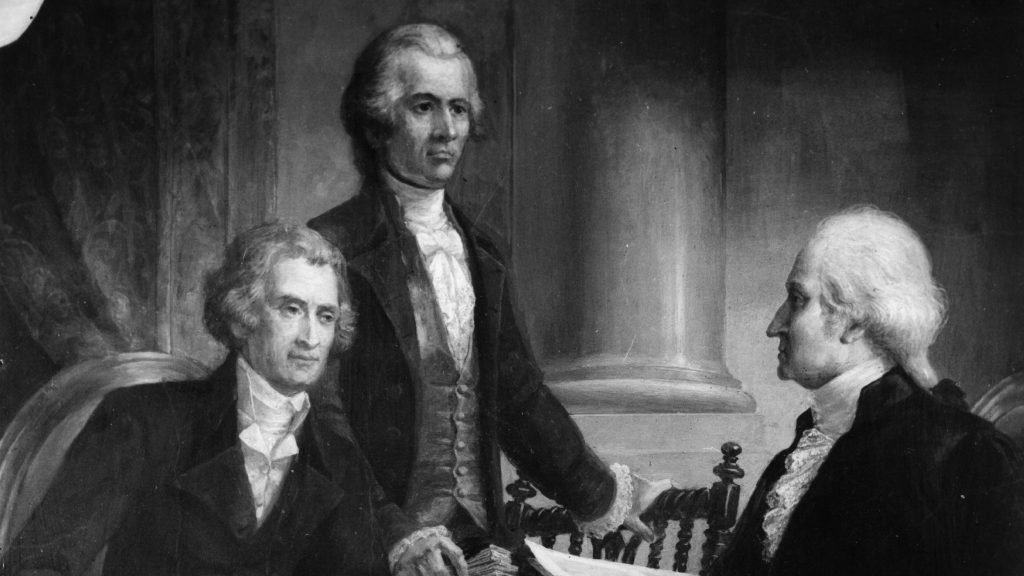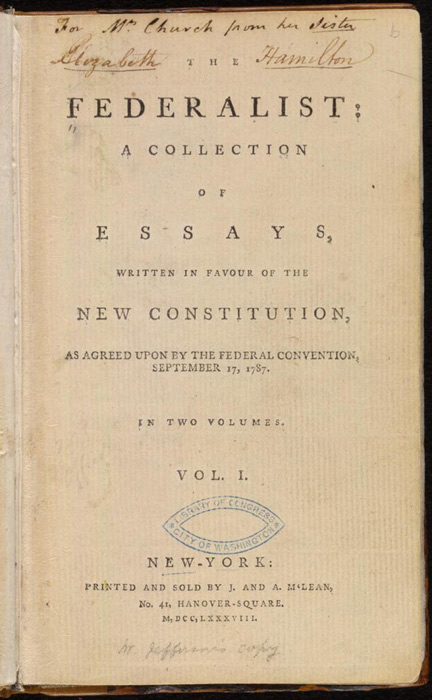The Creators & Process Behind the Federalist Papers
The Federalist Papers were a collection of 85 different essays that focused on explaining why there should be advocation for the ratification of the U.S. Constitution. Created between the years of 1787-1788, known for the famous line, “If men were angels, no government would be necessary.” (Federalist No. 51 James Madison)1. The papers were written by various authors such as Alexander Hamilton who was the nation’s first secretary of the Treasury, James Madison better known as the father of the Constitution, and John Jay who was the US secretary for foreign affairs. The group of Federalist political theorists had written under the pseudonym “Publius” to honor Publius Valerius Pubicola who was a Roman statesman who helped found the Roman Republic with the ideals of republicanism and democracy. Using this pseudonym, made people focus on what was being presented rather than who had authored these essays as a precaution to prevent personal bias. The main goal of these authors was to convince people that a stronger national government was needed to keep the country stable while protecting the people’s freedom. These essays had appeared in the New York newspapers meant to persuade the eye of the public and state legislators to support the drafted Constitution which would replace the weaker Articles of Confederation.2

The Importance of New Structure Needed for Government
After winning independence from Britain, the U.S. had to find some way to govern itself. Since the Articles of Confederation had created a weak central government, the problem was that most of the power was held by individual states. Leading to states arguing over trade and the national government not being able to fundraise enough money. Further, no dedicated support or army was created to keep the country stable and safe. To resolve this, during the Constitution Convention in 1787 they had created a plan; the U.S Constitution which was a document that would create a stronger central government with three branches; executive (the president), legislative (congress), and judicial (the courts). Checks and balances were added to ensure that no one part had too much power.3 With this new plan came the opposing side to this document, known as Anti-Federalists, who believed that this new government would become too powerful and take away individual freedom.4 This was the start of the Federalist Papers as Hamilton, Madison, and Jay began to draft these essays explaining why the Constitution was an innovative idea and why the country needed a stronger central government.
“Safety from external danger is the most powerful director of national conduct. Even the ardent love of liberty will, after a time, give way to its dictates. The violent destruction of life and property incident to war, the continual effort and alarm attendant on a state of continual danger, will compel nations the most attached to liberty to resort for repose and security to institutions which have a tendency to destroy their civil and political rights. To be more safe, they at length become willing to run the risk of being less free.” – Alexander Hamilton, The Federalist Papers
The papers themselves dive into how deeply divided the country was over how much power the government should have. The essays were not to just point out what the country needed but to help aid during a period where people were afraid of going back to a system such as the Britain monarchy that they had previously just fought against. Americans believed that a strong government was not to be trusted and would lead to tyranny. The Federalist Papers argued over how the Constitution was a careful curation to prevent that by creating a system where power was shared equally among the states and federal government, a balance between different branches. In the Federalist Papers Madison writes No.51 explaining how dividing power among the three branches would make sure no one branch could dominate the others.
“Double security arises to the rights of the people. The governments will control each other, at the same time that each will be controlled by itself by the use of checks and balances“ – James Madison (No.51) The Federalist Papers
The key was making sure to calm the public’s fears that one part of the government would get too strong and abuse its power. The wide range of topics placed in the papers covered; why a strong central government is needed, checks and balances, the benefits of unity, controlling factions, and other areas with the judicial branch and elections The papers themselves do not just surround the Constitution and redefining it to appeal to the public, they are about human nature and how people act when power is placed in their hands. In Federalist No.10, Madison talks about “factions”- which are groups of people with different interests- and how they can be dangerous due to them prioritizing their own interests ahead of the common good. The solution is a large republic where numerous groups exist, so no group can take control. Created by Hamilton, Madison, and Jay they were trying to convince people with their logical arguments that played on fear as a factor.5 One idea was that if the Constitution were not adopted then destruction would occur amongst the U.S. due to foreign powers or simply falling apart.
Future Importance of The Federalist Papers
The current relevancy on why The Federalist Papers are important in current times is they helped shape the U.S. government and are key items in research because of the fundamental questions addressed about areas such as; power, government, and human behavior. They exhibit how founders within the country thought about balancing the need for a strong government while protecting individual rights. The Federalist Papers shaped the way for the Constitution by addressing what the public needed to be resolved, which were fears and concerns around the time. More importantly, they explain the thinking that went on behind the Constitution and how the government is supposed to function, these are still extensive ideas that correlate to American politicians and government today.
References:
- [1] DEWEY, Joseph, PhD. Federalist Papers. Salem Press Encyclopedia, [s. l.], 2022
- [2] & [4] KYLE SCOTT. The Federalist Papers: A Reader’s Guide. New York: Bloomsbury Academic, 2013.
- [3] Ketcham, Ralph, ed. The Anti-Federalist Papers and the Constitutional Convention Debate. New York: Signet, 2003.
- [5] TAYLOR, Q. P. Publius and Persuasion: Rhetorical Readings of The Federalist Papers. Political Science Reviewer, [s. l.], v. 31, p. 236, 2002.
